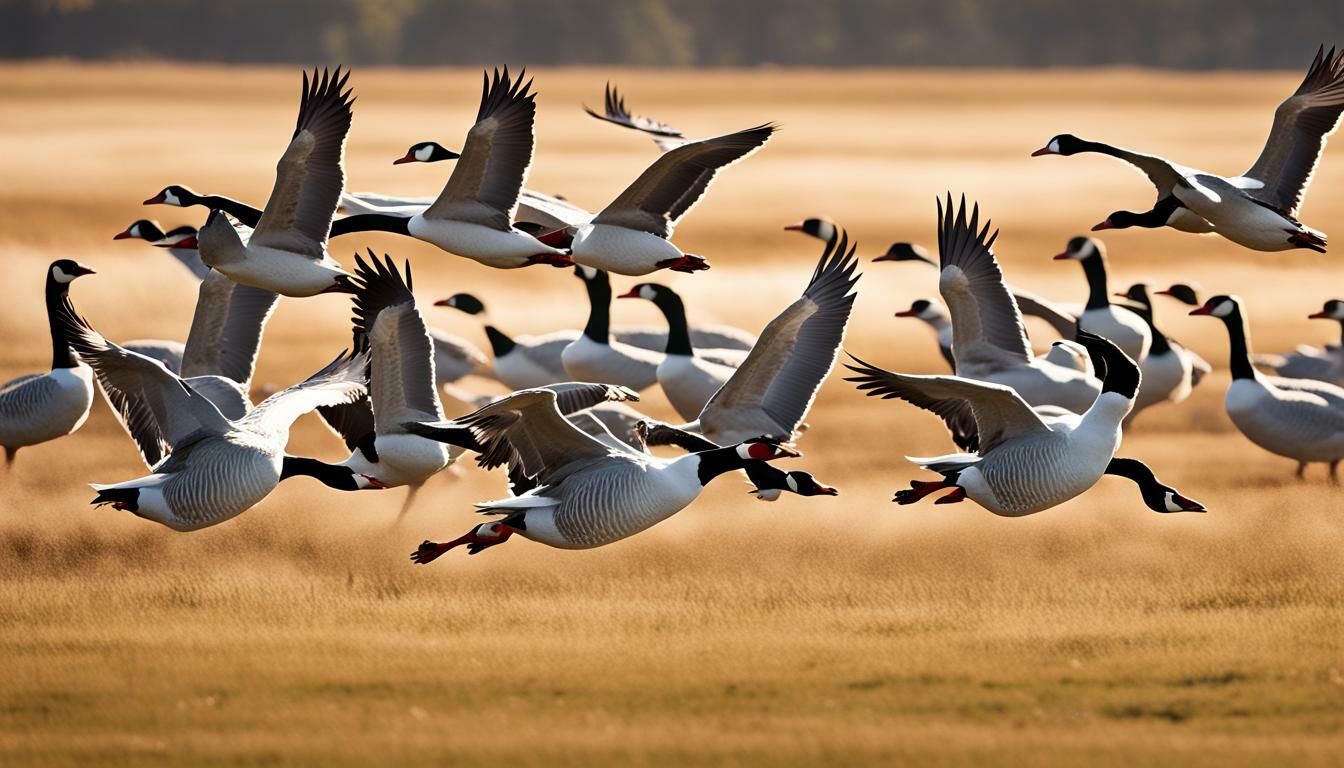How Fast Can Geese Run? Uncover the Speed

Table of content:
Geese are amazing birds – they can fly thousands of miles every year during migration. But did you know geese are also able to run very fast on land when needed? Their ability to sprint can be impressive. In this article, we’ll look at how fast geese can run, the factors that allow them to reach high speeds, and how their running ability benefits them.
What’s the Top Speed of a Goose on Land?
Most sources estimate that geese can run at peak speeds of around 15 miles per hour on land. This is for very short sprints of 50 to 100 yards in length. Geese aren’t able to maintain this pace for very long, but in short bursts, they can really pick up speed.
To put 15 mph in perspective, that’s about the same maximum speed that an average house cat can reach. It’s also faster than the top sprinting speed most humans can reach, which is around 15 mph at our peak physical fitness.
So in terms of land animals, geese are up there with some of the speediest when they need to sprint briefly. Especially considering their primary mode of transport is flying, the speed geese reach on foot is impressive.
How Can Geese Run So Fast When on Land?
Given that geese spend most of their lives swimming and flying, you might be wondering how they can run so fast on land. Well, geese have evolved a number of advantageous adaptations that allow them to reach speeds matching or exceeding many ground mammals.
Long, Strong Legs for Their Body Size
One major factor is that geese have relatively long legs compared to their bodies, which allows them to take big strides when sprinting. Their legs are positioned directly underneath their bodies, rather than farther back like many bird species.
This improved leverage helps propel their bodies forward with more power on each step. Those lengthy legs can cover more ground with each stride.
Their legs are also very muscular and robust compared to the rest of their lightweight, streamlined bodies. More of their muscle mass is concentrated in their thighs and shanks. This leg strength allows them to generate force against the ground on each step.
Specialized Foot Structure for Traction
Like other waterfowl, geese have webbed feet. This means their toes are connected by skin and membrane that aids their swimming. But it also gives them better traction on land to grip and push off as they run.
The webbing allows their feet to spread out the impact and grip better when sprinting on land. This reduces slipping and improves their acceleration when running on various surfaces.
Rapid Leg Cycling for Speed
When running fast, geese can cycle their legs incredibly quickly. They take many rapid, small strides rather than longer bounds like some mammals. This fast cadence of leg movement allows geese to cover ground swiftly.
Their rapid leg cycling compensates for a lack of stride length. They don’t take long bounds, but the frequent strides accumulate to reach fast speeds. This rapid rhythm of foot strikes lets geese sprint briskly even without big bounds.
Why Did Geese Evolve to Run So Quickly?
So why do geese need to run at speeds matching or exceeding many mammals and humans? What purposes do these short rapid sprints serve in the life of a goose? There are a few key reasons:
Fleeing Predators
Wild geese rely heavily on their speed to escape predators and other threats in their environment. Whether it’s a fox getting too close or a human encroaching near their nest, geese use rapid sprints to get away from danger quickly.
Their bursts of speed give them better odds of fleeing threats and reaching the safety of water or gaining flight. Outrunning predators is essential to the survival of geese since they are prey animals for many species.
Taking Flight Rapidly
Geese don’t take off flying directly from a standstill – they need to build up some velocity running on land first before getting airborne. Their ability to sprint gives them a “running start” that allows geese to take flight much more efficiently.
By accelerating to 10-15 mph on foot first, geese can more quickly attain the wing speed necessary to produce lift. So their running directly aids their ability to become airborne rapidly when necessary.
Migration Travel
The ability to sprint in short bursts aids geese over the vast distances traveled during their famous migrations. Geese use walking and running for much of migration, especially when stopping to rest and feed.
Being able to dash quickly helps geese keep up with their flock, dodge threats, and reach optimal feeding areas efficiently when migrating. Their short running bursts conserve vital energy during migration.
Establishing Dominance
Male geese often utilize their speed when defending mates, establishing dominance, and confronting intruders. They will aggressively rush toward opponent geese or other threats while running or flying at top speed.
This allows geese to be more successful in defending territory, resources and social status in their flock. So sprinting aids mating opportunities and survival.
How Does a Goose’s Running Speed Compare to a Human’s?
As noted earlier, a fit human can reach top running speeds of around 15 mph at peak physical fitness, which is about the same maximum speed as a sprinting goose. But humans have some advantages that allow us to outrun geese in certain scenarios:
- Endurance – Humans can run much farther and longer at moderate paces than geese, who tire quickly after sprinting. Our stamina gives us an edge in any prolonged chase.
- Acceleration – Geese need time to reach 15 mph after slowing down or stopping. Humans can accelerate to top speed more quickly from a standstill.
- Agility – Humans can also change direction far faster while running compared to geese. This allows us to outmaneuver them in confined spaces.
So while geese have impressive short-distance speed in a straight line, humans can outrun them in situations requiring endurance, rapid changes of direction, or repeated accelerations. But geese can still outpace humans in certain contexts due to their foot speed.
How Does the Running Speed of Geese Compare to Other Birds?
While geese are among the fastest-running birds, some larger species can match or exceed their top sprinting speeds. Some examples of birds with running speeds equal to or greater than a goose include:
- Ostriches – The largest living birds, ostriches can sprint at speeds over 40 mph using their powerful long legs.
- Emus – Close ostrich relatives, emus can run at over 30 mph at top speed. Their legs generate immense footspeed.
- Greater Roadrunners – These appropriately named desert birds can run up to 20 mph thanks to rapid leg cycling.
- Pheasants – Long-tailed gamebirds like pheasants can reach 18 mph sprints when alarmed and fleeing.
So while geese are fast on foot for their body size, larger flightless birds and certain gamebirds can run at even faster maximum speeds. But geese still outpace most smaller bird species when sprinting on land.
Do Geese Get Tired from Running at Top Speed?
Geese do get fatigued and require rest after sprinting short distances on land. Their leg muscles utilize anaerobic fast-twitch fibers that tire quickly with sustained use at high speeds. A goose can really only run at peak velocity in very short bursts less than 100 yards.
After sprinting, geese need time to recover and catch their breath before flying or running at top speed again. Their wings can help reduce leg fatigue from impact when running by providing some lift. But in general, geese try to avoid tiring sprints and pace themselves when migrating.
However, with adequate rest geese can regain their peak running speed fairly swiftly. Proper recovery allows them to sprint repeatedly when essential for survival or reproduction.
Final Thoughts
For birds best known for their graceful flying, geese are surprisingly swift sprinters on land as well. Using specialized adaptations like long strong legs, webbed feet, and rapid leg cycling, geese can briefly run at speeds up to 15 mph. This ability aids their survival, reproduction, and migration in many ways.
While not the absolute speediest of birds, geese are impressive runners given their aquatic lifestyle and flight focus. Their versatility of movement – running, flying, and swimming – gives geese a unique edge for thriving in diverse environments. So respect the sprinting skills of geese next time you encounter them on land!
Welcome. I’m Adreena Shanum, the proud owner of this website, and I am incredibly passionate about animals, especially poultry. I founded adreenapets.com as a labor of love, stemming from my desire to share my knowledge and experiences with poultry enthusiasts worldwide.




